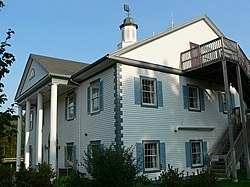Wells, Maine
| Wells, Maine | ||
|---|---|---|
| Town | ||

Town Hall
|
||
|
||
| Motto: The Friendliest Town In Maine | ||
| Location within the state of Maine | ||
| Coordinates: 43°19′13″N 70°36′42″W / 43.32028°N 70.61167°WCoordinates: 43°19′13″N 70°36′42″W / 43.32028°N 70.61167°W | ||
| Country | United States | |
| State | Maine | |
| County | York | |
| Founded | 1643 | |
| Incorporated | 1653 | |
| Government | ||
| • Type | Town Meeting, Board of Selectmen, Town Manager | |
| • Town Manager | Jonathan Carter | |
| Area | ||
| • Total | 73.61 sq mi (190.65 km2) | |
| • Land | 57.55 sq mi (149.05 km2) | |
| • Water | 16.06 sq mi (41.60 km2) | |
| Elevation | 177 ft (54 m) | |
| Population (2010) | ||
| • Total | 9,589 | |
| • Estimate (2012) | 9,748 | |
| • Density | 166.6/sq mi (64.3/km2) | |
| Time zone | Eastern (EST) (UTC-5) | |
| • Summer (DST) | EDT (UTC-4) | |
| ZIP code(s) | 04054 (Moody), 04090 (Wells) | |
| Area code(s) | 207 | |
| FIPS code | 23-81475 | |
| GNIS feature ID | 0582799 | |
| Website | www.wellstown.org | |
Wells is a town in York County, Maine, United States. Founded in 1643, it is the third-oldest town in Maine. The population in 2010 was 9,589. Wells Beach is a popular summer destination.
The Abenaki Indians called the area Webhannet, meaning "at the clear stream", a reference to the Webhannet River.
Edmund Littlefield, an immigrant from the wool regions of Titchfield, England, built the first gristmill and later a woolen mill on the Webhannet River, becoming known as "The Father of Wells," where a monument commemorates his contribution. In 1622, the Plymouth Company in England awarded to Sir Ferdinando Gorges, Lord Proprietor of Maine, territory which included the Plantation of Wells. His young cousin, Thomas Gorges, acting as deputy and agent, in 1641 granted to Rev. John Wheelwright and other settlers from Exeter, New Hampshire the right to populate the land from northeast of the Ogunquit River to southwest of the Kennebunk River. Following the death of the elder Gorges in 1647, the Massachusetts Bay Colony laid claim to Maine. In 1653, Wells was incorporated, the third town in Maine to do so, and named after Wells, England, a small cathedral city in the county of Somerset. It then included Kennebunk, set off the year Maine became a state in 1820, and Ogunquit, designated a village within Wells by the legislature in 1913, then set off in 1980.
Wells was the resilient northeastern frontier of English settlement. Except for a few forts and garrisons, early attempts to colonize Maine above Wells were abandoned because of attacks by Native Americans allied with New France, which resented encroachment by New England in territory it considered its own, Acadia. Wells endured three major attacks, most famously the Raid on Wells in 1692. The region became less dangerous, however, after the Battle of Louisburg in 1745.
...
Wikipedia


